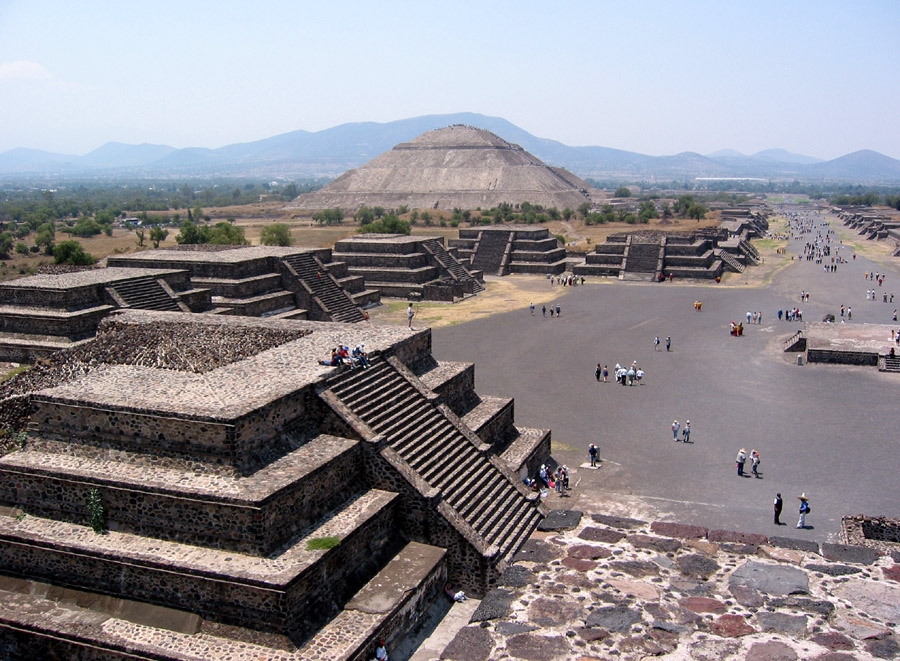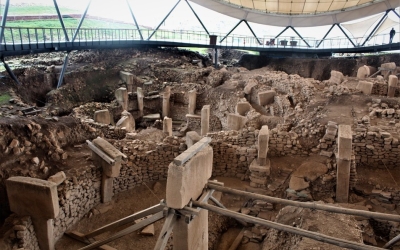David Graeber vs Yuval Harari: Exploding the myth of how civilisation began

It is tragic that we will never see a debate on the prehistoric origins of humankind between the late great David Graeber and the vastly over-promoted Yuval Noah Harari, the coffee table reseller of Enlightenment fables about human development.
Graeber was an activist and anthropologist who died in 2020, just before the publishing of his final work, The Dawn of Everything. It is a fitting testament to a lifetime devoted to challenging capitalist orthodoxy in the humanities and politics.
This familiar narrative has somehow survived against the ever mounting evidence that the transition to farming, large states and empires was far more contingent, and often reversed
The book, co-authored with archaeologist David Wengrow, is a stunningly original riposte to the big beasts of grand narrative histories of the world such as Jarrod Diamond, Steven Pinker and Harari.
Thanks to the work of anthropologists and archaeologists, the evidence has been building in recent decades pointing to complex forager societies which built monumental sites and supported large settlements over thousands of years of prehistory.
This flies in the face of the traditional school of human evolution which told us that complex societies, those that built great monuments and urban settlements, did not exist prior to the spread of agriculture (if they did build anything noteworthy it was effectively dismissed as an anomaly to the rule). This view can no longer be sustained, and yet many big-name writers persist with this orthodox view of humanity's journey.
New MEE newsletter: Jerusalem Dispatch
Sign up to get the latest insights and analysis on Israel-Palestine, alongside Turkey Unpacked and other MEE newsletters
The complex foragers are the inconvenient truth of our prehistory, roughly from 9000 BCE to 3000 BCE, that Graeber and Wengrow illuminate with reference to more recent indigenous societies in the Americas, Africa, Oceania and elsewhere.
One of the most famous sites that exemplifies this is Gobekli Tepi in southeast Turkey, dating to some 9000 BCE, a site of spectacular sculptures, huge gatherings, and probable human sacrifice. Infuriatingly, it is treated as an afterthought in Harari's Sapiens, despite its construction 7000 years before Stone Henge and thousands of years before the first major civilisation of the classical era in the Fertile Crescent. It is one of numerous monumental sites built by forager (hunter-gatherer) cultures, requiring a major rethink of traditional theories about the emergence of agriculture and the first states.
This remarkable site has little or no place in the outdated version of prehistory usually called the "agricultural revolution". Yet for Graeber and Wengrow, it forms an important part of the story of the upland sector of the Fertile Crescent among other megalithic sites erected 5000 years before the conventional start of the Middle East civilisation narrative.
In Sapiens, Harari rehashes the traditional view of human development from the Stone Age - in which he compares early humans to primates. "The most important thing to know about prehistoric humans is that they were insignificant animals with no more impact on their environment than gorillas, fireflies or jellyfish."
Then, with the so-called cognitive revolution, we move from tribal nomadic society to the birth of agriculture (humans blindly working for wheat), ancient empires and finally capitalist modernity. It's a process which Harari depicts as largely inevitable and arriving at the best of all worlds, the one we live in now: global neoliberal capitalism.
This familiar narrative has somehow survived against the ever mounting evidence that the transition to farming, large states and empires was far more contingent, and often reversed.
Noble savage myth
As Graeber and Wengrow remind us, the idea of the noble savage, who at some point discovered the secrets of farming, leading to the descent of man into a system of hierarchy, exploitation and oppressive states was not based on evidence at all. It was a speculative theory thought up by Jean Jacques Rousseau and other European writers in the 18th century.
In The Dawn of Everything, the authors show that when crop growing began in what is now Jordan, Iraq, Syria and Turkey, around 11,000 years ago, it did not quickly alter the established seasonal foraging and hunting patterns and instead was complementary to it.
Over 4,000 or more years, neolithic societies in the Fertile Crescent, where wheat cultivation and animal herding began, continued to forage and hunt and follow a seasonal pattern of existence; they gathered in settlements for a few months and then dispersed into smaller groups during the hunting seasons.
The domestication of wheat took 3000 years, a very slow revolution indeed.
Unlike modern hunter-gatherers who only survive in remote regions, the fisher-foragers of the past often lived on the coast and at the mouths of rivers and deltas in places of abundance in fish life, fauna and easily gathered wild crops. There was sufficient food for surpluses to support complex settlements and for the building of large monuments for ritual and seasonal gatherings, as seen in pre-Columbian Mississippi and Stone Henge.
Such societies did not support a permanent ruling class and did not evolve into states, as happened much later, even if certain individuals were elevated to higher, sometimes sacred, status. Wealth was not usually hereditary and there was no equivalent to modern money. Land ownership was communal and often rotated by lot (It was only the Romans who established the concept of absolute private ownership of property, rather than stewardship, points out Graeber).
Projecting capitalism backwards
In other words, these societies were not in a headlong rush towards state building, class differentiation, and private property. In much macro-history writing, a neoclassical idea of economic rationalism is projected back onto neolithic societies, seeing patterns of accumulation and inequality that really belong to the modern era, and dismissing evidence that doesn't confirm this.
In Europe, the arrival of farming some 5000 years ago lasted several hundred years but was violently ended when the settler communities were attacked and slaughtered by surrounding forager peoples, as evidenced by the presence of mass graves. Only later was agriculture once again adopted.
'Popular councils and citizen assemblies were stable features of government in Mesopotamian cities'
- The Dawn of Everything
The authors also show that the earliest cities in Ukraine and Mesopotamia of the 4th millennium BCE were egalitarian and organised without the presence of kings, temples or royal palaces. Even where kings appeared, they had to tread carefully. "Popular councils and citizen assemblies were stable features of government in Mesopotamian cities", and among neighbouring peoples such as the Hittites, Phoenicians and Philistines. All of this predates the Athenian assemblies that we usually assume to be the birthplace of democracy.
The first warrior aristocracies of the late 4th millennium "emerged in opposition to the egalitarian cities of the Mesopotamian plains", a clash between warrior elites and urban societies that is a common theme across history.
The fundamental question that The Dawn of Everything opens up is the idea that history is a unidirectional process towards farming, hierarchy, states, empires and capitalism. This is the convenient view of late capitalist ideology projecting our particular historical epoch, which is barely 500 years old, back through the millennia to hugely diverse societies.
Indigenous critique
While mainstream western historians exalt our civilisation as having the highest values of morality compared to the tyrannies and barbarism of the past, the Wendat people of the American northeast had a dim view of European society they encountered 300 years ago, what the authors call the indigenous critique.
As Wendat intellectual Kandiaronk put it to a French interlocutor: "To imagine one can live in the country of money and preserve one's soul is like imagining one could preserve one's life at the bottom of a lake. Money is the father of luxury, lasciviousness, intrigues, trickery, lies, betrayal, insincerity - of all the world's worst behaviours."
Perhaps Harari and Graeber would agree on one thing at least: both accept that the human capacity to create and change the stories and myths that guide us is our unique and abiding gift for changing the world.
Middle East Eye delivers independent and unrivalled coverage and analysis of the Middle East, North Africa and beyond. To learn more about republishing this content and the associated fees, please fill out this form. More about MEE can be found here.







